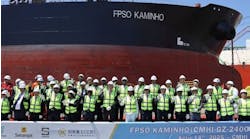Brazil's Round 3 licensing, concluded on June 19-20, has consolidated the opening of the Brazil's oil and gas exploration and production sector. A total of 41 qualified companies were in Rio de Janeiro to present their bids for the 53 blocks on offer. A total of 36 concessionaires already hold explor-ation and production rights in Brazil, and a significant number of discoveries already have been announced.
The objectives of Agência Nacional do Petróleo (ANP or Brazil's National Petroleum Agency) for Round 3 licensing included attracting companies of all sizes and developing exploration and production activities throughout the country. Some of Brazil's 29 sedimentary basins, which cover an area of 6.4 million sq km, have never been drilled.
Round 3 licensing offered blocks in a variety of basins, ranging from exploration frontiers to mature basins, including onshore, shallow, and deepwater blocks.
Apart from the well-known Campos and Santos basins, Brazil Round 3 also offered opportunities in the Recôncavo, Potiguar, and Espírito Santo, which are mature basins, as well as blocks in the Barreirinhas, Ceará, and Jequitinhonha basins, for the first time. Opportunities are also available in the Paraná, Pará-Maranhão, Sergipe-Alagoas and Camamu-Alamada basins.
First two rounds
Brazil's first licensing round was announced less than one year after the 1988 creation of the ANP. In June 1999, 14 companies presented bids on 12 of the 27 blocks on offer. Included among these companies were all of the majors and some large independents.
The Espírito Santo and Campos basins attracted the largest bids by area, but a block in the Santos Basin attracted the largest bid (approximately $75 million). Although the bidding round was a big success, many blocks did not receive offers, including 4 blocks onshore.
Although state-owned Petroleo Brasileiro S/A (Petrobras) was successful in bidding in five blocks, the proportional area distribution showed Agip as the largest winner. Agip received 26% of the awarded acreage, followed by Texaco (20%), Petrobras (13%), and Exxon (11%).
To attract more companies to Brazil Round 2, ANP changed the qualification procedures and the minimum work obligations. Minimum shareholders' equity was reduced from $10 million to $1 million in some onshore blocks, and all drilling obligations were removed from the first exploration period. Calgary, Tokyo, and Perth were included in the roadshow itinerary with the aim of bringing smaller companies into the process.
Investors dig deeper
The response from the industry was positive, with 48 companies paying the participation fees, 44 qualifying, and 27 presenting offers for 21 of the 23 blocks on offer. These 21 blocks were conceded to 16 companies from eight countries. According to the proportional area distribution, Petrobras was the largest winner. Petrobras has 30.3% of the total conceded acreage, followed by El Paso (17.3%), Chevron (10.9%), and Shell (9%).
The Espírito Santo Basin attracted the largest bid in Round 1, closely followed by the Campos Basin. In Round 2, the Santos Basin attracted higher bids, again followed by the Campos Basin. These three basins are considered today as the most prospective in Brazil. An accompanying table shows the average winning bid per block in each basin offered in Rounds 1 and 2, together with the average value per sq km in each of the basins.
New bidding round
For Brazil Round 3, ANP is offering a record 53 blocks in 12 sedimentary basins, a product of a flurry of nominations from industry and better knowledge of the offshore basins, due to the enormous amount of seismic data collected.
In 1999 and 2000, a very significant portion of the world seismic fleet was at work offshore Brazil. The peak was reached in the first quarter of 2000, when 22 seismic vessels were operating simultaneously.
The seismic data acquired on a non-exclusive basis can be counted toward the minimum work obligations in the licensed blocks. From Brazil Round 1 on, 3D seismic data was eligible. Round 2 included 2D onshore data. Round 3 included 2D transition zone seismic data (water depth to 50 meters).
Broader interest
Round 3 followed 19 companies reporting 125 discoveries in 12 sedimentary basins. Forty-six companies have formally expressed interest in Round 3 licenses. This expands interest in Brazil to 19 countries and represents all of the continents. The companies paid about $10.6 million in participation fees, entitling them to a digital data package containing information about the blocks.
The list of the 41 qualified companies has been published on www.Brazil-Round3.com, where the bidding results were published in real time on June 19-20.
The bids consist of a signature bonus and two percentages representing a concessionaire's commitment to procure goods and services from Brazilian suppliers in the exploration phase and in the development stage of the production phase.
Operators were qualified as class A, B, or C, depending on their operating experience. Class A operators can operate in all 53 blocks, while class B operators can operate in shallow water and onshore blocks. Class C operators can operate in the eight onshore blocks located in mature basins. The winners must sign the concession agreement by the end of September.
Author
Ivan de Araújo Simões Filho holds a BS in Geology from the University of Nancy (France) and a Ph.D. in Geophysics from the University of Bahia (Brazil). He is General Manager of Licensing Rounds at the Brazilian National Petroleum Agency (ANP), Professor of Reservoir Geophysics at the University of Campinas, and Vice-President of the Brazilian Geophysical Society.




